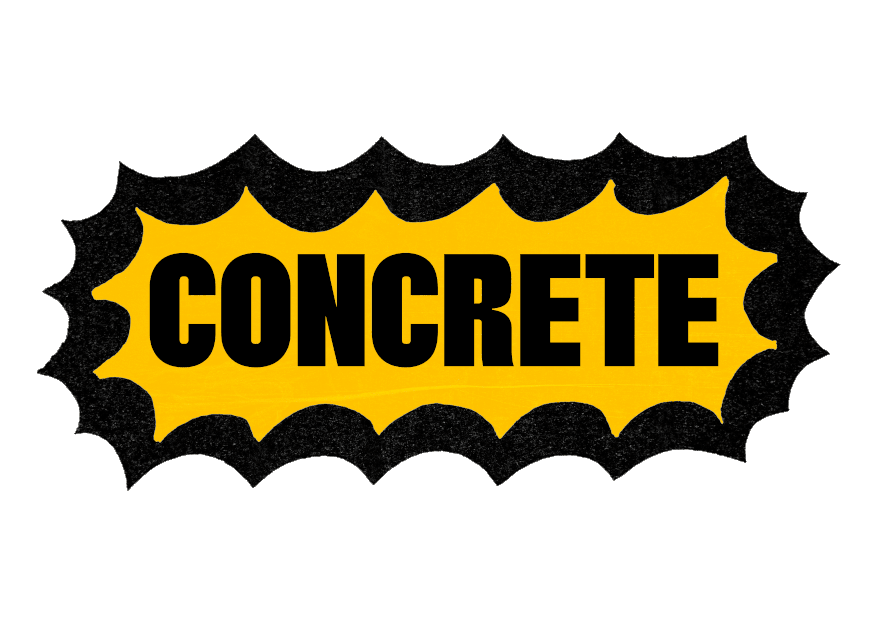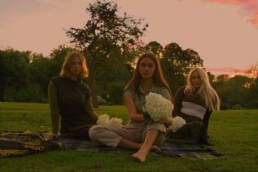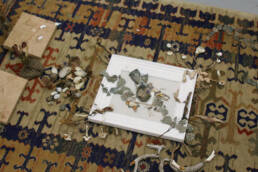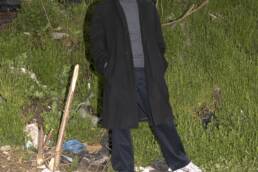CONCRETE met Tomas Gittins, the tangent king whose brightly coloured ‘poortraits’ are blowing up fast. We talked toys, anime and ghosts, and attempted to find out who Duvall is.

Poortraits, Gittins, 2022.
I: How would you explain what you do to a person in the street?
G: I try to express myself as best I can with whatever medium I have in front of me. It’s been spray paint, but recently I’ve been adding a bit of oil crayons in there. It’s therapeutic. That’s why I make ‘poortraits,’ because I’m letting out my poor traits, as well as them being bad drawings.
I: Who are they portraits of?
G: People I see in my head. *laughs* It’s not anyone. Everyone says ‘you’ve got your demons,’ and I was going through a tough time in my own head. This led me to start thinking about making them into characters – perhaps soft and cuddly ones, like my toys – to take the power away from this looming thing. I think that’s what most of my characters are – demons in some sense.
I: To me, less desirable qualities and inner demons feel like different things; demons are the personification of that phrase, ‘there’s a voice in my head’.
G: Would you not call that a bad trait in itself, that part of yourself conspires against you, though? I bring them all together. Your demons give you your bad traits. If you’re greedy it’s because a little voice in your head is saying “take that shit”. I put my poor traits into my art to work on myself, really. Every piece I do is a bad feeling I’ve had that day; “I’m selfish, I’m lazy, I’m whatever,” I think to myself. When I make an artwork of that feeling, I either let it go or I realise a poor trait within myself. It’s a bit like in Card Captor, the anime, when the girl does a spell to capture something in a card – like greed or something. That’s what I want to do with my art work. I’m letting my demons out and then they are trapped in that artwork.
I: What else does ‘poortraits’ mean?
G: It also means ‘bad’. These are quick drawings of faces. They aren’t anatomically correct. Poor portraits. Anyone could draw a face, but the messiness gives it a style. When something isn’t totally polished, when there’s drips in the work, lines running over in the work, you can take more from it because it’s not how you’d necessarily think it would be.
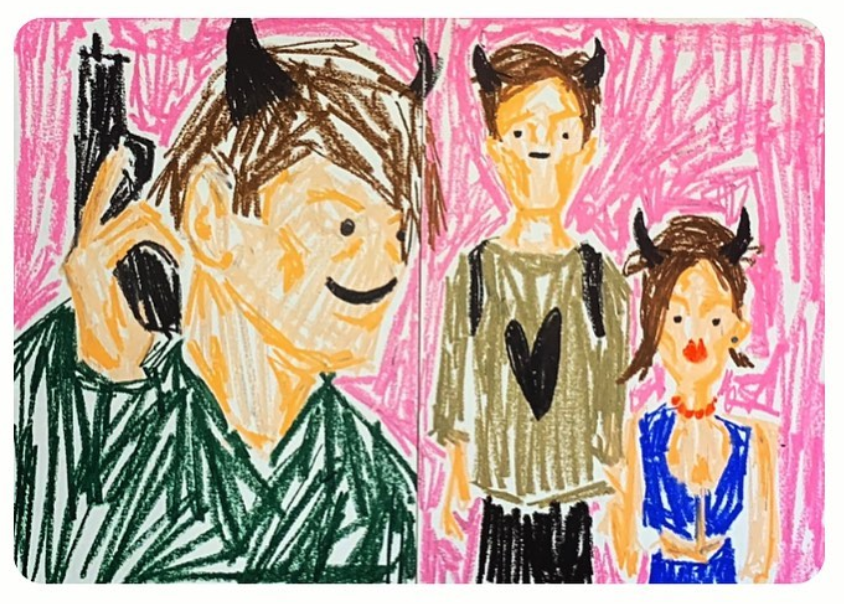
Untitled, Gittins, 2020.
I: There is an immediacy to your work. These are very smooth and simplistic lines. What does this visual simplicity give your practice?
G: It’s an instinct thing. As soon as there is any resistance, and it’s not instinctual, that piece of paper is getting a knife through it. It’s not that it has to be perfect, but it has to evoke a feeling. I have to look at it and get a sense of release from it. I’ve just been given this air brush and now I’m gonna work longer on a piece. Immediacy is part of my style, but it’s also a by-product of the mediums I use at the moment. Spray has to be immediate. Now I’ve got this spray gun, trust me, man, it’s gonna pop.
I: Why do you work on such big canvases?
G: It’s a stylistic choice as well as a practical one. The problem with spray is that the thinnest line I can do isn’t that thin, which annoys me sometimes. These practical and financial things do constrain my work a little. Plus, I’m slowly killing myself with spraying in my current space. It’s tiny, that studio. It’s in an office building in Macclesfield. It feels gnarly sometimes, if you don’t wear a mask in there you’ll be done in. If I’m in there every day I notice it less, but when I go in once a week I leave feeling bonged out my head.
I: How has your practice evolved?
G: The first works were oil crayons. The first work I sold was in oil crayon. Then I did spray paint, but now it’s just whatever I can get my heads on. Sometimes I use oil crayon to add detail at the end. I’d use blueberry juice if I had to. I just can’t stop, d’you know what I mean?
I: How long have you painted for?
G: I’ve been doing art all my life. I went to art college for a little bit but was kicked out because I was a rascal. I knew I was going to Cape Town as well so I felt like I was at the last day of a shit job every day for the time I was in college. They didn’t like the stuff I was doing. I can’t wait to go back with a fat cheque and throw singles at their heads.
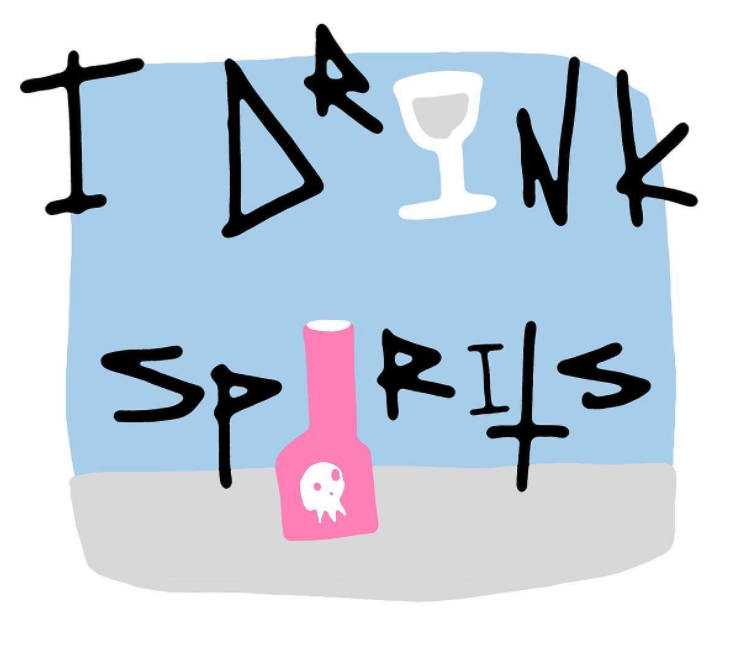
I Drink Spirits, Gittins, 2021.
I: What other mediums do you use?
G: I just produce and produce and produce – I can’t stop. It’s hard for me to narrow it down to one thing. I like animation. I draw animations on MS Paint. I’ve done a design called We Drink Spirits, but instead of liquor it’s ghosts. In the animation, someone pours spirit and then this creature comes out of the glass. I want to make more animations, to be fair. I’ve done graffiti, too. There’s one up from The Castle Hotel in the Northern Quarter. I’ve got a new graffiti name as well – Duvall. When I was a kid I used to come up from our cellar and go to my dad, “this guy in the cellar told me ‘when I was Duvall I used to do this’,” I was chatting to ghosts and shit.
I: Who is Duvall?
G: I don’t know man! It’s just what my dad talked about. I want to do the Duvall thing big, because it’s just cool, like when that fucking ghost was like “when you were Duvall,” and I could graff ‘when I was Duvall,’ and bang! *laughs* Duvall sounds a bit too close to the devil for my liking, mind.
I: How does your work being a therapeutic outlet correspond with its message?
G: I don’t think there is just one message or meaning. It’s how people are responding to the work which matters to me. Luke Unabomber messaged me the other day and said he’d seen my work in Seesaw, on Princess Street, and said “I was having a shit day until I saw your work”. That felt good. I draw the shit in my book, I blow it up to A1 size, then bam! I just draw scenes and characters in my head and people can take it how they take it. Putting too much of a label on my work takes the joy away I find.
I: What is your scene?
G: From the get go I want to be a global person. I like Manchester and our artists here, but I think my art scene is in my own head. I follow artists from all over: Hungary, Tokyo, New York. I don’t want to pigeonhole myself into a Manchester art scene.
I: Tell me about a great moment in your career.
G: I showed work in a pop up in Soho for Niihai. My art was there for a month and we had a party. It was next! I don’t look back though. I want to create my own shows, with live music and everything. Talking to Zach Zono – an artist and friend, and his brother Alex – we’ve always felt the same; we work hard now so we can get more money to facilitate working hard on bigger shit in the future. It’s all about output. It’s about working to get dough so you can put that into making something new that’s even better. Am I answering your questions? I’m the tangent king.
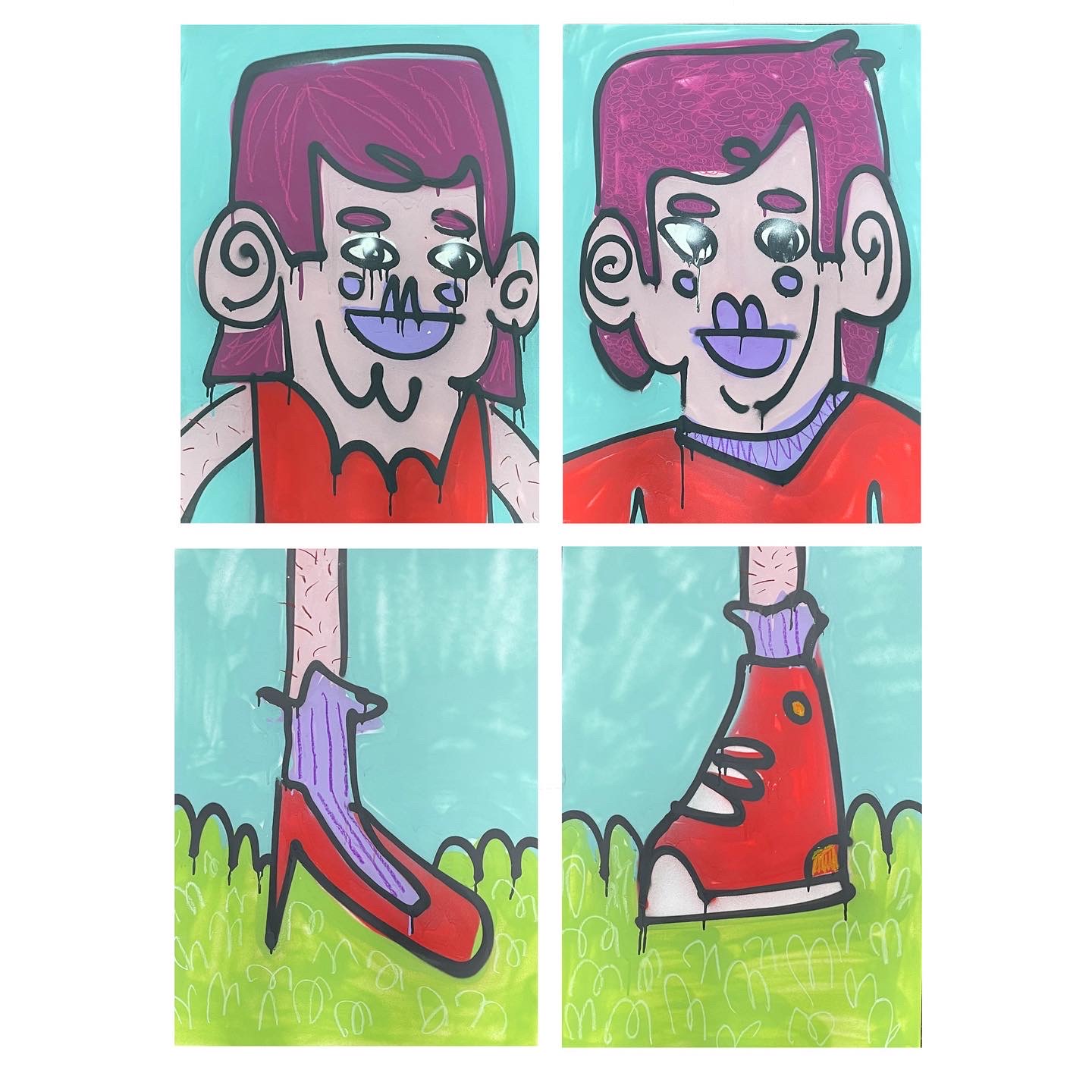
Head2toe, one of Gittins’ Poortraits, 2022.
I: What have you got coming up?
G: I’ve got a show at 180 Strand in London which I’m excited about. It’s a swap and meet between artists, but people can come and buy stuff, too. A Swiss company messaged me about collaborating on some quilts, too. They show stuff in New York which is exciting. I’m going to Cape Town in June, too, and I’ll show work there. I haven’t done any “art art” out in South Africa yet, but next time I go I want to hold a show there. I seem to know quite a few artists in Cape Town who are doing pretty well at the moment. They’re talented out there. I just want to expand, because I’m very new to what I do at the moment. What’s really coming next: keeping going and pushing it as hard as I can. I want all my future shows to be an experience.
I: What does the Tomas Gittins exhibition experience look like, then?
G: A cliche art exhibition – you know, quietly nodding at an acquaintance when you see something good, pinky out, glass in hand – isn’t for me. My work isn’t meant to be shown in that way, it should be enjoyed with your friends, a little bit tipsy, walking around, seeing some cool things, saying, “isn’t this band good?”. I’ve got ten things going on in my head at all times and I want to communicate that with a show. I want sculptures, animations on the wall, music as a score to the animation. I want it to be multisensory. It’s gonna be a madness.
I: Who influences your work?
G: I don’t know. I just draw what’s in my head. Of course, I like looking at different things and drawing from different references, but it’s more likely to be the way I see a person, say, look up than take direct inspiration from another artist. Of course, there are artists I love, though. I really like Anthony Lister, the Australian artist, I found out about him when his documentary was on Netflix. It was sick. Obviously, I love Keith Haring, too. The characters and lines morph into each other, especially with my new stuff. The way he worked […] he doesn’t think – the thinking happens when his pen is on the page and his thought is through the line. The vision just comes. I see the characters I paint in just as bright colours as I paint with. When I was in Brazil, the guy I was graffiting with told me the mural was like a Keith Haring. *laughs*
I: What’s worth getting out of bed for?
G: In my room on my wall I’ve stuck a piece of paper up that says ‘Tokyo show’. That’s what I’m working up to. I love anime and I love toys. The Japanese toy culture is elite. The way my art is going, I think that culture would receive it best. Artists that I really like have shown work in Japanese galleries. I follow Futura 2000, the graffiti artist, and he went to Japan and did stuff over there. KAWS went to Japan and made a toy and of course – Keith Haring! People in Japan loved his shit.
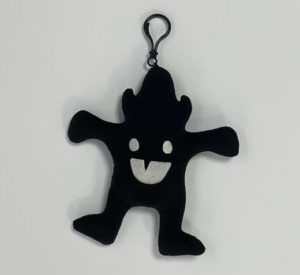
One of Gittins’ demon toys, 2021.
I: Talk to me about toys.
G: I love toys. Toys are just miniature, interactive sculptures. The ones I make are a way of combating the anxiety and demons I have in my own head. I’d like to make big ones as well as the small ones I already make. I’d love to have a place in my gallery where it was a corner of soft toys where you could go and sit between the legs of a huge toy I’ve designed; while you watch an animation featuring the same characters; and look at paintings on the wall, almost like storyboards for the toys. It’s a way to make my shows more immersive.
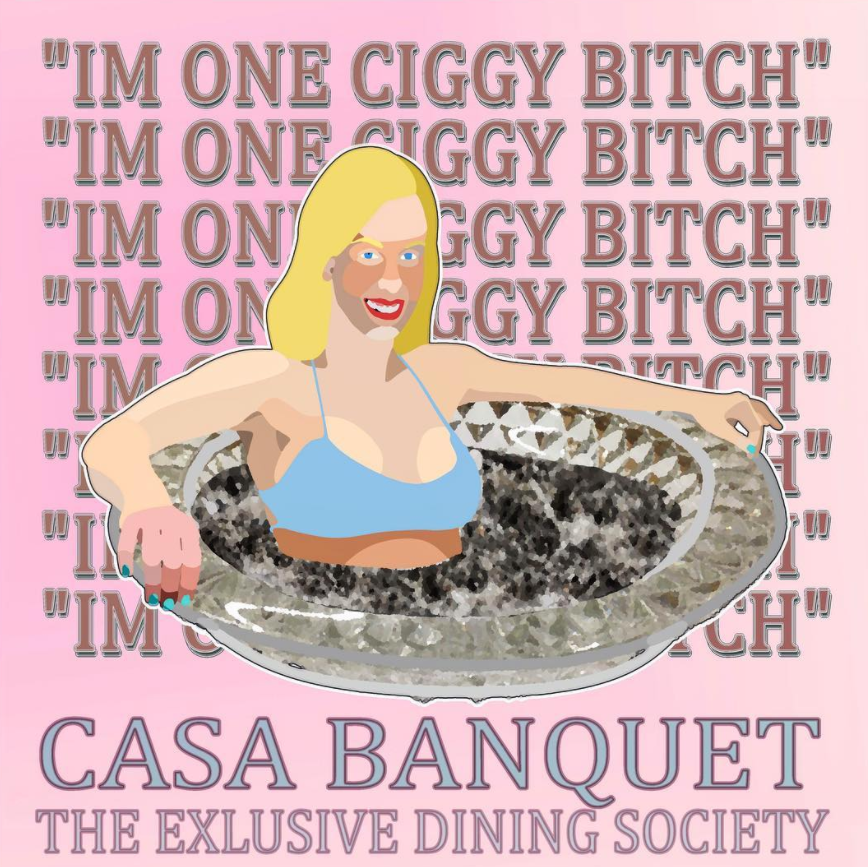
Casa Banquet, Gittins, 2018.
I: Tell me about your clothing brand, OYU LITTLE DEMONS.
G: When I went to Cape Town, I started making these edits. I love starting these little things. I made this thing called Casa Banquet – an exclusive dining society that didn’t really exist. It was all these t-shirt designs to do with food. When I came back from Cape Town I started doing t-shirt designs by myself because I wanted to start a clothing brand. I made clothes and gave them to people for free. Having something to make feels more important than money. Now I have OYU LITTLE DEMONS, which is about inner demons, and that’s a new way to get my clothing out there. I’ve got a collaboration with Sampaix on the t-shirts coming up that I’m dead keen for.
I: What’s something you tried for the first time this year and enjoyed?
G: Painting my first wall. It was out in the open and it was my first collaboration in Brazil, it was sick. I could hear my grandma chatting shit behind me in Portuguese to all these guys, as well. She fucking knows everyone’s secrets. It’s a big town but she knows a lot of secrets. She’s a Brazilian donny. It was pretty good spray painting out in the favela, hearing gunshots behind you. I did two pieces in Brazil and they were both murals. I love doing big murals.
I: What was it like making art over there?
G: It was good. I felt anxious doing my first mural because it was my first one. It felt the same as well though, because I kept on drawing in my sketchbook, watching Netflix and drawing shit on the wall – so the same as I normally do. I feel at home over there, which helps, too.
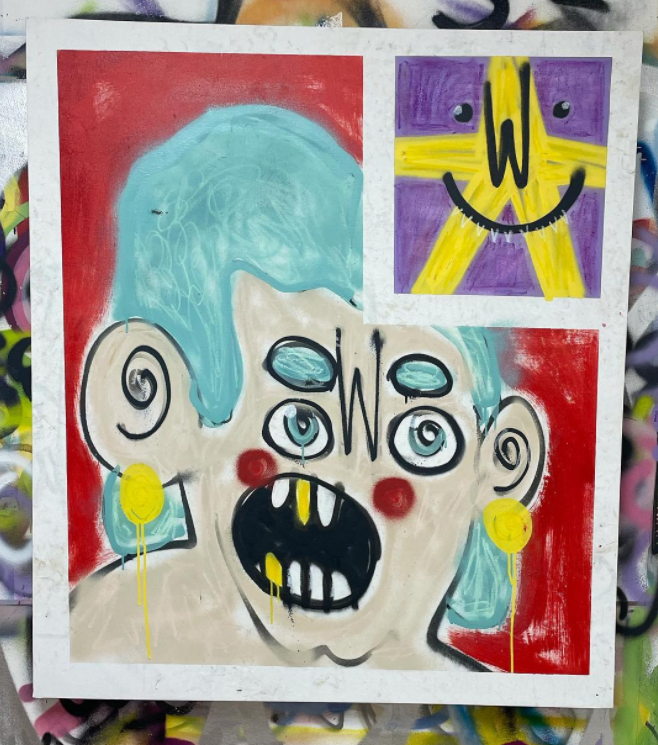
Untitled Poortrait, Gittins, 2022.
I: If you could travel in time, when would you go?
G: Probably to the Wild West. I’d definitely get smacked up in the first second though. *laughs* It would be sick though! Chill at home, have a drink, get on your horse, gallop away and go on a quest. You could stumble on some mad shit back then. You can’t stumble on anything these days. I’d probably get mad chaffing but fuck it.
I: How would you like to be remembered?
G: As a nice guy who looked after his friends. Maybe as a bit mysterious, too.
I: *laughs* It’s funny to me to hear you say “mysterious” when your paintings are so sunny and brightly coloured.
G: I know. *laughs* I feel like I tell people a lot of stuff and they think they get the whole picture when they don’t. I’ll tell a person something but I’ll only give them a surface level deepness. People still think, ‘he’s gone pretty deep on this,’ but really you’ve given them the deepness you give everyone. Really there’s more to it. I got baggage. That’s for another time, though.
All images are property of the artist. You can check out Gittins’ work and OYU LITTLE DEMONS on his instagram here. Gittins will also be exhibiting work at CONCRETE’s launch on March 23rd.
